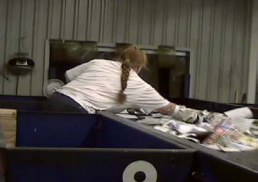Concern details
Background:

Multiple stations in the recycling facility have workers visually inspect recyclable material that is traveling down an automated conveyer. The workers are required to remove any refuse or other material which is non-recyclable from the conveyor into bins beside or behind the worker. The vertical heights of the conveyer range from 89-108cm, except for the final newsprint sort which has a conveyer surface height of 50 cm and has newsprint piled to approximately 127 cm. The width of the conveyers range from 155-160 cm, although there are workers on both sides of the conveyer if the person across from the worker is busy the worker will reach past the half-way point to retrieve a piece of refuse.
Evaluation:
The extended horizontal reach to the midpoint of the conveyer (80 cm) creates repetitive awkward shoulder and back postures and is above anthropometric functional reach guideline of 70 cm [1]. This task results in repetitive reaching across the conveyors [2]; therefore, the recommended maximum forward reach for repetitive tasks is 50 cm [1]. The horizontal reach required when sorting recyclables results in repetitive awkward back and shoulder postures which are cause for concern.
Countermeasures
To eliminate the repetitive awkward shoulder and back postures the maximum horizontal reach distance should be 50 cm [1]. It is recommended to investigate devices which reduce the horizontal reach such as pole with a clamp on the end to retrieve the refuse. The reach distance can also be reduced by adding a line at the midpoint of the
conveyer to ensure workers are not picking across the middle of the conveyer. The optimal countermeasure would be to re-design the conveyer system with maximum conveyer width of 100 cm, this would result in a 50 cm horizontal reach to the center of the conveyer. Implementing these countermeasures will reduce the risk of injury to the workforce.
References
- Eastman Kodak Company. (2004) Kodak’s Ergonomic Design for People at Work (2nd Edition) (S. N. Chengalur, S. H. Rodgers, and T. E. Bernard, Eds.) John Wiley and Sons, Inc., New Jersey.
- Kilbom, A. (1994). Repetitive work of the upper extremity: Part II: The scientific basis for the guide. International Journal of Industrial Ergonomics, 14:59-86.